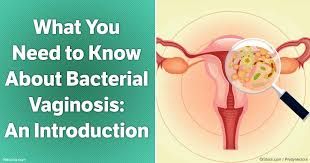BACTERIAL VAGINOSIS
Bacterial Vaginosis(BV) is a condition that occurs when there is too much of a certain bacteria in the vagina. I.e It is the overgrowth of a particular bacteria in the vagina.

It is a very common vaginal infection especially in women between the ages of 17 and 44.
FACTS ABOUT BV
•Having BV can increase your chances of getting other STDs.
•BV rarely affects women who have never had sex.
•You cannot get BV from toilet seats, beddings, or swimming pools.
•The infection does not get passed on to male sexual partners.
Most of the time, BV doesn’t cause any other health problems. But it can lead to other issues, especially when you’re pregnant or trying to get pregnant.
SYMPTOMS OF BACTERIAL VAGINOSIS

Not every woman with BV has symptoms but the most common is a change in vaginal discharge.
• A thin white or gray vaginal discharge;
• Pain, itching, or burning in the vagina;
• A strong fish-like odor, especially after sex
• Burning when urinating;
• Itching around the outside of the vagina.
HOW BV DEVELOPS
BV occurs when the acidity of the vagina changes. The most common causes are:
• Using perfumed soap to wash the vagina, when you often use vaginal deodorants, douching (washing out your vagina) – all these upsets the natural balance of bacteria
• When semen enters the vagina
– sexual intercourse without a condom
• Using strong detergents to wash your underwear
• Using an IUD (intra-uterine contraceptive device – a “coil”)
HOW IS BACTERIAL VAGINOSIS TRANSMITTED?
The cause of BV is unknown. It is however, known to typically occur in sexually active women. BV is linked to an imbalance of “good” and “harmful” bacteria that are normally found in a woman’s vagina.
Having a new sex partner or multiple sex partners places a woman at increased risk for getting BV.
DIAGNOSIS

You need to check in with your gynaecologist.
The diagnosis of BV is made by looking at a specimen of your vaginal discharge under a microscope, and from the examination by your doctor.
TREATMENT
Treatment is often easy. You will be prescribed antibiotic tablets, gel or cream to put inside the vagina. It is always important that you finish the course of treatment, even if your symptoms disappear before you’re done with the medications prescribed by your doctor. If you use an IUD and BV keeps coming back (recurrent BV), you may want to talk to your doctor about a different type of birth control instead.

